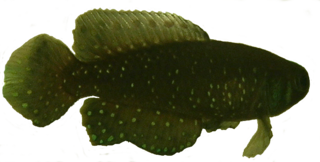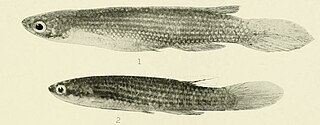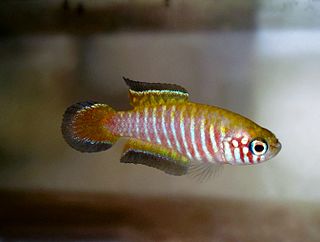
Hypostomus is a genus of catfish in the family Loricariidae. They are native to tropical and subtropical South America. H. plecostomus is the popular freshwater aquarium fish formerly known as Plecostomus plecostomus. The taxonomic structure of the Loricariidae is still being expanded by scientists. Hypostomus is a highly species-rich and widely distributed catfish genus.

Astyanax is a genus of freshwater fish in the family Characidae of the order Characiformes. Some of these fish, like many of their relatives, are kept as aquarium pets and known collectively as tetras. With around 150 described species and new ones being described yearly, this genus is among the largest of the entire order; Hyphessobrycon also has more than 145 species and which one is larger at any one time depends on whether more species have been recently described in one or the other. The blind and colorless cave tetra of Mexico is a famous member of the genus, but its taxonomic position is disputed: Some recognize it as part of the Mexican tetra and this is supported by phylogenetic evidence, but others recognize the cave form as a separate species, A. jordani.

Geophagus is a genus of cichlids that mainly live in South America as far south as Argentina and Uruguay, but a single species, G. crassilabris is from Panama. They are found in a wide range of freshwater habitats. They are part of a group popularly known as eartheaters and mostly feed by picking up mouthfuls of sediment to sift out food items such as invertebrates, plant material and detritus. The largest species reach up to 28 cm (11 in) in standard length. They are mostly kept in aquariums.

Leporinus is a genus of fish in the family Anostomidae native to South America. The fossil species Leporinus scalabrinii, known from the late Miocene of Entre Ríos in Argentina, has only recently been added to this genus after being misidentified as a species of primate under the name Arrhinolemur scalabrinii for over 100 years.

The Pimelodidae, commonly known as the long-whiskered catfishes, are a family of catfishes.

Jenynsia is a genus of freshwater fishes in the family Anablepidae. Like Anableps species, they are onesided livebearers: some sources indicate that they only mate on one side, right-"handed" males with left-"handed" females and vice versa. However, other sources dispute this. These South American fish are viviparous.

Steindachneridion is a genus of South American pimelodid catfish.

Pimelodus is a genus of fish in the family Pimelodidae native to Central and South America.
Hisonotus is a genus of armored catfishes native to South America. Species of Hisonotus and Curculionichthys are the only representatives of the subfamily Otothyrinae having serrae on the posterior edge of the pectoral fin spine. These species are small fishes, generally found in small fast flowing streams, where they grasp to the branches and leaves of aquatic or subaquatic plants. The species of this genus mostly occur in Atlantic coastal streams of southern Brazil and the Paraguay-Paraná system of southern South America. They are also distributed in the Río de La Plata basin and coastal rivers of southeastern Brazil.

Parotocinclus is a genus of fish in the family Loricariidae native to South America. This genus is distributed through almost all hydrographic systems in South America from the Guyana Shield drainages and Amazon Shield tributaries to the coastal drainages of eastern and southeastern Brazil, including the rio São Francisco basin. Most species have the caudal peduncle oval in cross section. It has been found that Characidium species may interact with P. maculicauda. The small Characidium will follow grazing P. maculicauda, which release particulate matter dislodged from the catfish's foraging.

Cynolebias is a genus of freshwater annual killifish in the family Rivulidae. They are endemic to northeastern Brazil, generally in temporary waters such as ponds in the Caatinga and adjacent regions. By far the highest species richness is in the São Francisco River basin, but there are also species east and north of this system, and west as far as the Tocantins River basin. Many species have rather small distributions and some are highly threatened.

Fluviphylax is a genus of tiny poeciliids native to the Amazon Basin, Orinoco Basin, and Oyapock Basin in South America.

Phallotorynus is a genus of poeciliid toothcarps native to southern Brazil, northern Argentina, and Paraguay.

Austrolebias is a genus of killifish in the family Rivulidae. These annual killifish live in temporary pools, swamps and streams in the Río de la Plata, Patos–Mirim and Mamoré basins in South America.

Anablepsoides is a genus of killifish in the family Rivulidae native to tropical South America and the Lesser Antilles. The majority are from the Amazon and Orinoco basins, as well as freshwater systems in the Guiana Shield, but a few species are from northern Venezuela, northeastern Brazil and the Lesser Antilles. Although largely restricted to lowlands, a few species occur in the lower East Andean foothills. They are mostly found in shallow fresh water swamps, streams, edges of rivers, ponds and pools, but a few may occur in brackish estuaries. They are able to jump over land and breathe air for short periods, allowing them to access isolated waters inhabited by few or no other fish. Several Anablepsoides species have small distributions and some are seriously threatened by habitat loss; the entire known range of A. xinguensis is in the area flooded by the Belo Monte Dam.

Simpsonichthys is a genus of killifish from the family Rivulidae the species of which are endemic to temporary freshwater habitats like ponds in the upper Paraná, upper Araguaia, upper Jequitinhonha and São Francisco basins on the central Brazilian Plateau. They are small annual killifish that reach up to 5.5 cm (2.2 in) in standard length.
Cnesterodon carnegiei, commonly known as Carnegie's toothcarp, is a species of poeciliid native to southeastern Brazil and Uruguay.
Cnesterodon raddai, the Resistencia toothcarp, is a species of poeciliid native to the Paraguay and lower Paraná River basins.
Cnesterodon brevirostratus, is a species of poeciliid found in Brazil.
Cnesterodon septentrionalis, is a species of poeciliid found in Brazil.















